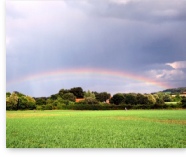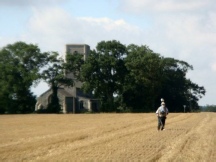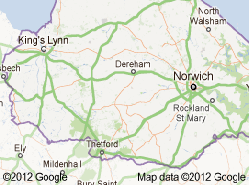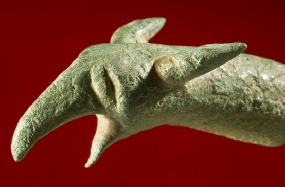

Touching the hand of history™


Discovery Tours
The Location
 England is rich in history
England is rich in history
Simply put, England offers the perfect location for our detecting tours.
It had many early invaders, starting with Julius Caesar and his Roman Legions in 55 BC and ending with William I of Normandy who conquered the Saxons at Hastings in 1066 AD. All of whom left this historic trail behind them.
On the trip you can expect to hunt fields that were occupied by ancient Celts and Romans 2000 years ago, and then shared in turn by Anglo Saxon, Viking and Medieval civilizations up to modern times.

Norfolk: the jewel in England's crown
The county of Norfolk, where out tours are based, is situated to the east of England in the area of East Anglia.
Our host David Barwell discusses below Norfolk's rich and plentiful history:
“Norfolk is a large farming county, which as yet is still relatively unspoilt by motorways and urbanisation. Due to its size we are able to hunt in many areas that have never been detected before.
The county had a high population in the Bronze Age and leading into the Iron Age (Celts). Norfolk was also the homeland of the famous Celtic ‘Queen’ Boudicca and her Norfolk tribe of the Iceni led the revolt against the Romans and nearly won! 
When the Romans left, in or around 410 AD, the Anglo Saxons or the Angles (hence the name East Anglia) migrated to Norfolk and settled, where they occupied the land for around six hundred years. Although Anglo Saxon metalwork is rare, Discovery Tours has managed to locate Anglo Saxon habitation areas and find significant quantities of metal artefacts year after year, along with a smattering of later 9th/10th century Viking metalwork.
 After the Norman invasion of 1066, and on into Medieval times, Norfolk became a rich county on the back of the wool trade and general commerce. Most of which was traded from now disappeared ports around the Norfolk coastline.The Black Death in 1348 killed four out of every seven people in the county and today areas of Norfolk have not recovered to their previous numbers. You will see evidence of wealth and decline as you travel around the county, you will spot many large grand, almost cathedral like, churches in the landscape all alone!
After the Norman invasion of 1066, and on into Medieval times, Norfolk became a rich county on the back of the wool trade and general commerce. Most of which was traded from now disappeared ports around the Norfolk coastline.The Black Death in 1348 killed four out of every seven people in the county and today areas of Norfolk have not recovered to their previous numbers. You will see evidence of wealth and decline as you travel around the county, you will spot many large grand, almost cathedral like, churches in the landscape all alone!
I find my particular style of research works well when finding ‘archaeologically rich areas’ in Norfolk, which is primarily based on identifying clues in the landscape. We also have an excellent relationship with the Norfolk Archaeology and Museums Service. They support and interact with us and we support them – we record everything over 300 years old as part of the Portable Antiquities Scheme – and the participants show a true regard for English history by often donating significant items to the museum.
We have found many archaeological sites in the landscape, which help interpret the history of Norfolk and continue our quest each year to discover and understand our ancestors!” 
Right: Roman Bronze griffin head
Donated to Norwich Castle Museum
By Jim C in 2000
Photograph copyright of Norwich Castle Museum & Art Gallery

You will be searching in the footsteps of these early people, near villages listed in the Doomsday Book, compiled in 1096 AD, and hunting in fields in the vicinity of castles and churches built by the Normans in the 11th and 16th centuries.
| Your Hosts |
| Location |
| Detecting |
| Identification |
| Responsible Detecting |
| Testimonials |
| Accommodation |
| 2023 Tour pics |
| Finds Archive |
| Museum Donations |
| 2019 Finds |
| Bronze Age to Iron Age |
| Roman |
| Anglo Saxon to Viking |
| Medieval |
| Post-Medieval |
| AngloSaxon to Post Medieval Donations |
| page two 2018 |
| Pastimes |